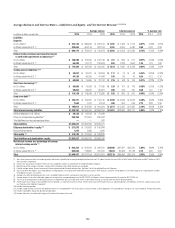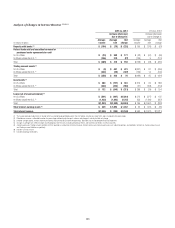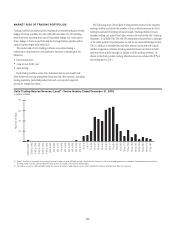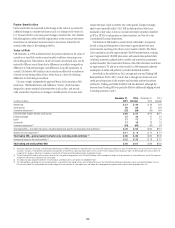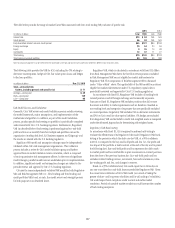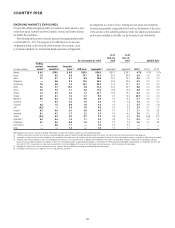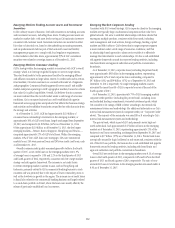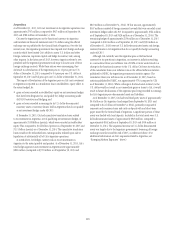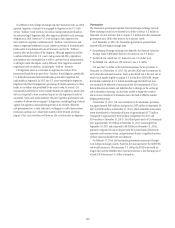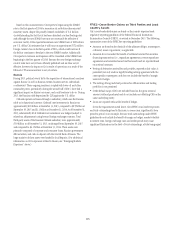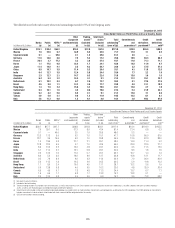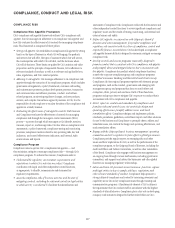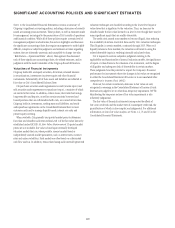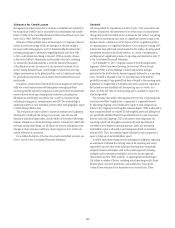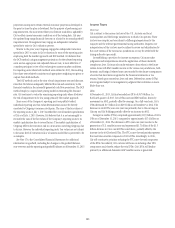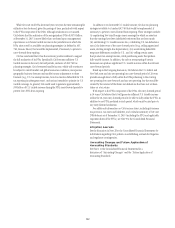Citibank 2015 Annual Report Download - page 130
Download and view the complete annual report
Please find page 130 of the 2015 Citibank annual report below. You can navigate through the pages in the report by either clicking on the pages listed below, or by using the keyword search tool below to find specific information within the annual report.112
Emerging Markets Trading Account Assets and Investment
Securities
In the ordinary course of business, Citi holds securities in its trading accounts
and investment accounts, including those above. Trading account assets are
marked to market daily, with asset levels varying as Citi maintains inventory
consistent with customer needs. Investment securities are recorded at either
fair value or historical cost, based on the underlying accounting treatment,
and are predominantly held as part of the local entity asset and liability
management program or to comply with local regulatory requirements.
In the markets in the table above, approximately 99% of Citi’s investment
securities were related to sovereign issuers as of December 31, 2015.
Emerging Markets Consumer Lending
GCB’s strategy within the emerging markets is consistent with GCB’s overall
strategy, which is to leverage its global footprint to serve its target clients.
The retail bank seeks to be the preeminent bank for the emerging affluent
and affluent consumers in large urban centers. In credit cards and in certain
retail markets, Citi serves customers in a somewhat broader set of segments
and geographies. Commercial banking generally serves small- and middle-
market enterprises operating in GCB’s geographic markets, focused on clients
that value Citi’s global capabilities. Overall, Citi believes that its customers
are more resilient than the overall market under a wide range of economic
conditions. Citi’s consumer business has a well-established risk appetite
framework across geographies and products that reflects the business strategy
and activities and establishes boundaries around the key risks that arise from
the strategy and activities.
As of December 31, 2015, GCB had approximately $110 billion of
consumer loans outstanding to borrowers in the emerging markets, or
approximately 38% of GCB’s total loans, largely unchanged from September
30, 2015 and compared to $118 billion (41%) as of December 31, 2014.
Of the approximate $110 billion as of December 31, 2015, the five largest
emerging markets—Mexico, Korea, Singapore, Hong Kong and Taiwan—
comprised approximately 27% of GCB’s total loans. Within the emerging
markets, 30% of Citi’s GCB loans were mortgages, 26% were commercial
markets loans, 24% were personal loans and 20% were credit card loans, each
as of December 31, 2015.
Overall consumer credit quality remained generally stable in the fourth
quarter of 2015, as net credit losses in the emerging markets were 1.9%
of average loans, compared to 1.8% and 2.2% in the third quarter of 2015
and fourth quarter of 2014, respectively, consistent with Citi’s target market
strategy and risk appetite framework. The increase in net credit losses
in certain emerging market countries in Asia, such as Hong Kong and
Indonesia, primarily related to Citi’s commercial banking business in such
countries and was primarily due to the impact of lower commodity prices as
well as the slowdown in growth in the region. The increase in net credit losses
in Brazil also related to the commercial banking business and largely related
to a wind-down portfolio in Brazil, where the losses were mostly offset by the
release of previously-established loan loss reserves.
Emerging Markets Corporate Lending
Consistent with ICG’s overall strategy, Citi’s corporate clients in the emerging
markets are typically large, multinational corporations that value Citi’s
global network. Citi aims to establish relationships with these clients that
encompass multiple products, consistent with client needs, including
cash management and trade services, foreign exchange, lending, capital
markets and M&A advisory. Citi believes that its target corporate segment
is more resilient under a wide range of economic conditions, and that
its relationship-based approach to client service enables it to effectively
manage the risks inherent in such relationships. Citi has a well-established
risk appetite framework around its corporate lending activities, including
risk-based limits and approval authorities and portfolio concentration
boundaries.
As of December 31, 2015, corporate loans (excluding the private bank)
were approximately $93 billion in the emerging markets, representing
approximately 43% of total corporate loans outstanding, compared to
$97 billion (43%) and $99 billion (47%) as of September 30, 2015 and
December 31, 2014, respectively. No single emerging markets country
accounted for more than 6% of Citi’s corporate loans as of the end of the
fourth quarter of 2015.
As of December 31, 2015, approximately 75% of Citi’s emerging markets
corporate credit portfolio (excluding the private bank), including loans
and unfunded lending commitments, was rated investment grade, which
Citi considers to be ratings of BBB or better according to its internal risk
measurement system and methodology (for additional information on Citi’s
internal risk measurement system for corporate credit, see “Corporate Credit”
above). The majority of the remainder was rated BB or B according to Citi’s
internal risk measurement system and methodology.
The private bank, which is part of ICG and primarily serves high-net-
worth individuals, had approximately $17 billion of loans in the emerging
markets as of December 31, 2015, representing approximately 25% of the
business’s total loans outstanding, unchanged from September 30, 2015 and
compared to $17 billion (27%) as of December 31, 2014. Private bank loans
are typically secured by liquid collateral or real estate and, consistent with the
rest of the ICG loan portfolio, the business has a well-established risk appetite
framework around its lending activities, including risk-based limits and
approval authorities and portfolio concentration boundaries.
Overall ICG net credit losses in the emerging markets were 0.1% of average
loans in the fourth quarter of 2015, compared to 0.0% and 0.4% in the third
quarter of 2015 and fourth quarter of 2014, respectively. The ratio of non-
accrual ICG loans to total loans in the emerging markets remained stable at
0.4% as of December 31, 2015.


